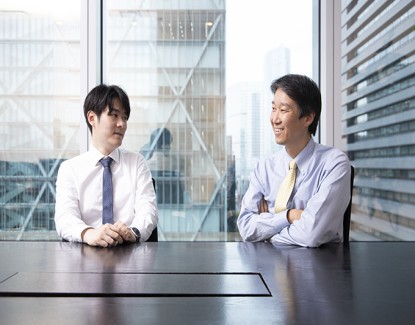Finding Compelling Japanese Small-Caps
The Portfolio Managers discuss their bottom-up approach to identifying undervalued small-cap companies and where they are currently finding opportunity.
-
 Takenari Okumura, CMAPortfolio Manager
Takenari Okumura, CMAPortfolio Manager -
 Tadahiro Fujimura, CFA, CMAPortfolio Manager
Tadahiro Fujimura, CFA, CMAPortfolio Manager
Key Takeaways
» The Fund seeks small-cap companies with strong growth potential, particularly those undergoing corporate reforms.
» We are currently finding opportunities in the semiconductor sector, particularly in companies involved in semiconductor manufacturing equipment and materials.
» Many small companies are boosting efficiencies and adopting new practices to manage rising wages while maintaining profitability.
» Companies such as JFR and Treasure Factory are benefiting from the weaker yen due to increased demand from tourism and a shift towards secondhand goods, respectively.
» We believe Japanese small-cap stocks present compelling investment opportunities with more attractive valuations compared to U.S. stocks.
Would you please discuss how the Fund navigated the sluggish Japanese market in 1Q25?
We believe maintaining a bottom-up approach remains essential, as market volatility presents valuable opportunities to uncover overlooked investment prospects. We continue to focus on companies with strong growth potential, particularly those undergoing corporate reforms, such as enhancing financial discipline. These efforts are expected to significantly bolster their corporate value over the long term.
What changes were made to the portfolio in 1Q25?
During the first quarter of 2025, we made several adjustments to the portfolio. New investments were made in companies expected to benefit from structural reforms, such as improving financial discipline, despite short-term challenges like the reactionary decline in special demand and stagnation in certain business segments. We also took advantage of the correction in semiconductorrelated stocks. We view this downturn as an attractive opportunity for medium- to long-term investments in companies with high structural growth potential. Additionally, we continue to invest in multiple semiconductor-related companies, particularly those with strong global market shares in specific processes.
In what sectors are you currently finding opportunity? What sectors look less attractive and why?
We are currently finding opportunities in the semiconductor sector, particularly in companies involved in semiconductor manufacturing equipment and materials. Despite market fluctuations and uncertainty, the semiconductor industry is expected to experience structural growth driven by technological innovation and the expanding range of applications. There are attractive prospects among small- and mid-cap companies with strong global market shares in specific processes, as well as those that have achieved significant growth through technological advancements. Additionally, the logistics sector presents opportunities, as companies in this space can pass on price increases due to robust demand. Moreover, companies focused on improving low-margin areas stand to enhance profitability and corporate value, making them promising investment targets. This focus on operational efficiency and leveraging pricing power creates strong investment potential.
On the other hand, we remain cautious about the artificial intelligence (AI) driven semiconductor segment in the short term, given the uncertainty surrounding demand from China and concerns about weaker growth in end markets, such as smartphones. We are also less optimistic about companies that have recently seen price surges due to merger and acquisition (M&A) or acquisition expectations. Stocks in sectors where valuations have been inflated by managed buyout announcements or acquisition speculation appear less attractive, as their perceived value has risen, reducing their upside potential.
Japan wage negotiations in large companies look to be delivering record pay increases in 2025. How are small companies expected to respond and how could this affect consumer spending in Japan?
In 2025, large companies in Japan are expected to offer record pay increases, which will likely improve income levels for many workers. While small companies may face challenges in matching these wage hikes directly, they have opportunities to respond in ways that could positively impact their growth.
Many small companies are focusing on efficiency improvements, including investing in labor-saving technologies and automation, which can help maintain profitability while managing wage increases. Additionally, small businesses are increasingly adopting new management practices and corporate governance reforms that enhance their capital efficiency, potentially boosting their competitiveness.
The effect of these wage increases on consumer spending in Japan is expected to be positive, especially if sustained wage growth spreads beyond large corporations and boosts the purchasing power of workers in smaller businesses. As wages rise, consumer sentiment could improve, leading to an increase in consumer spending, which has been sluggish in recent years. If small companies can also boost productivity and maintain profitability despite higher wages, it could contribute to a broader recovery in domestic consumption, supporting long-term economic growth in Japan.
With the yen continuing to be weak, would you please discuss an example or two of a holding where growth is exceeding expectations?
The Bank of Japan is continuing its process of monetary normalization, but interest rates remain low, and the Japanese economy is still in a state of easy monetary conditions. Given the ongoing concerns over inflationary pressures from the U.S. tariff policies, it is unlikely that the interest rate differential between Japan and the U.S. will narrow rapidly, and we expect the current exchange rate levels to continue for some time.
JFR, which operates department stores and commercial facilities, is among companies benefiting from the weaker yen. While Japan’s prices are on the rise, it is still considered an attractive destination globally. The company has stores not only in the Tokyo metropolitan area but also in major regional cities. As tourism expands to these areas, driven by measures such as overtourism countermeasures, JFR is expected to capture additional demand. Furthermore, its group company, PARCO, which operates shopping centers, is undergoing a rebranding process. While PARCO currently has low brand recognition, it is anticipated to become a growth driver that distinguishes JFR from its competitors.
Treasure Factory, a company specializing in second-hand goods, benefits from the weaker yen. In Japan, second-hand items traditionally had a negative image. However, rising prices for new products due to inflation and yen depreciation have lowered the psychological barriers to purchasing second-hand goods, as consumers seek more economical options. The company operates not only large-scale general stores but also specialized stores (such as those for sports goods and different price ranges of apparel), successfully attracting customers who were previously hesitant about second-hand items. Additionally, growing global demand for retro items, which previously had little market value, is further boosting the company’s performance, alongside the expansion of inbound tourism.
Would you discuss the M&A landscape in Japan and any holdings that have been involved in transactions?
The M&A landscape in Japan has undergone a notable transformation in recent years, with companies becoming more proactive in utilizing M&A to drive growth and business expansion. Traditionally, Japanese firms were cautious about M&A, preferring organic growth. However, in response to shifting market dynamics, aging populations, and increasing global competition, there has been a growing recognition of the strategic value of M&A.
Maeda Kosen, in particular, has leveraged M&A to expand its business areas, moving from its original focus on contract textile processing to civil engineering materials. The company has also acquired businesses in agricultural materials and products to prevent damage from wild animals. However, one of its most significant recent transactions was the acquisition of Mitsui Chemicals Industrial Products Ltd., a civil engineering and construction materials manufacturer that is a group company of Mitsui Chemicals. This acquisition, which is considered Maeda Kosen’s largest deal to date, is expected to drive growth through Post-Merger Integration.
In general, M&A activity in Japan has been on the rise, particularly as companies like Maeda Kosen seek to diversify, enter new markets, and enhance their competitiveness. The shift in Maeda Kosen’s approach toward more strategic acquisitions, paired with improved management techniques under President Takahiro Maeda, positions the company to capitalize on the growing opportunities in its respective markets.
Would you please compare the valuations of Japanese small-cap companies to U.S. small-cap companies at the end of the first quarter of 2025?
We think Japanese small-cap companies have been undergoing significant improvements in efficiency and management practices, driven by factors like corporate governance reforms and a focus on capital efficiency. These companies are also benefiting from rising consumer spending and wage growth, which could drive increased demand for their products and services. Despite facing challenges in matching wage increases from larger companies, many Japanese small caps are more adaptable and innovative, allowing them to stay competitive and potentially unlock significant value. Additionally, Japanese companies have stronger balance sheets compared to their U.S. counterparts, making them less vulnerable to the impact of rising interest rates. We believe Japanese small-cap stocks present compelling investment opportunities with more attractive valuations compared to U.S. stocks.
- In this article:
- Japan
- Japan Small Cap Fund
You might also like
-
 Portfolio Perspective
Portfolio Perspective
Japan Small Cap FundA Focus on Japanese Small-Caps Making Big Corporate Improvements
 Takenari Okumura, CMAPortfolio Manager
Takenari Okumura, CMAPortfolio Manager Tadahiro Fujimura, CFA, CMAPortfolio ManagerRead the Commentary
Tadahiro Fujimura, CFA, CMAPortfolio ManagerRead the CommentaryThe Portfolio Managers discuss their view of the Japanese small-cap corporate landscape amid many shifting factors, including a new Prime Minister, finalized tariff situation, currency volatility, and attractive valuation environment.
-
 Portfolio Perspective
Portfolio Perspective
Japan FundCompelling Japanese Opportunities Amid Attractive Valuations
 Masakazu Takeda, CFA, CMAPortfolio Manager
Masakazu Takeda, CFA, CMAPortfolio Manager Angus Lee, CFAPortfolio ManagerRead the Commentary
Angus Lee, CFAPortfolio ManagerRead the CommentaryThe Hennessy Japan Fund Portfolio Managers highlight the effect of the new Prime Minister on the economy and market and how holdings were affected by the final trade agreement. They also discuss currency volatility, valuations, and the most compelling opportunities as we end 2025.
-
 Investment Idea
Investment IdeaCompelling Valuations in Japan
 Masakazu Takeda, CFA, CMAPortfolio Manager
Masakazu Takeda, CFA, CMAPortfolio Manager Angus Lee, CFAPortfolio Manager
Angus Lee, CFAPortfolio Manager Tadahiro Fujimura, CFA, CMAPortfolio Manager
Tadahiro Fujimura, CFA, CMAPortfolio Manager Takenari Okumura, CMAPortfolio ManagerRead the Investment Idea
Takenari Okumura, CMAPortfolio ManagerRead the Investment IdeaJapanese equities are currently trading at compelling valuation levels compared to other developed equity markets around the world and relative to their own historical averages. We believe the Japanese market deserves a closer look.
